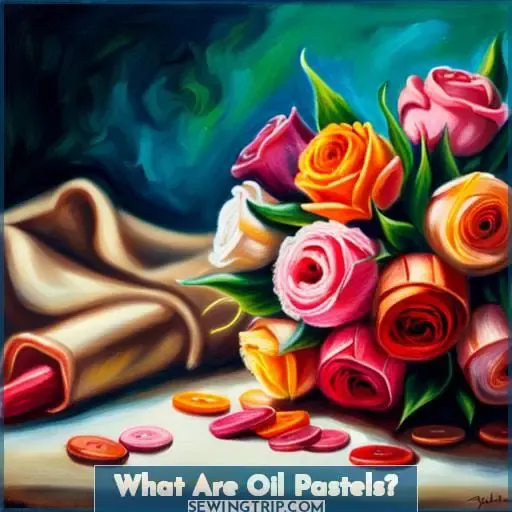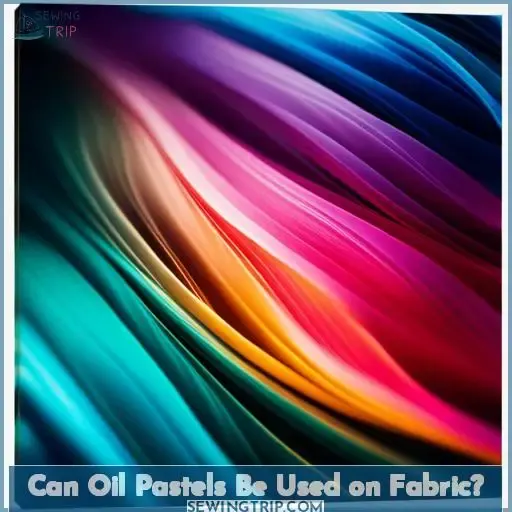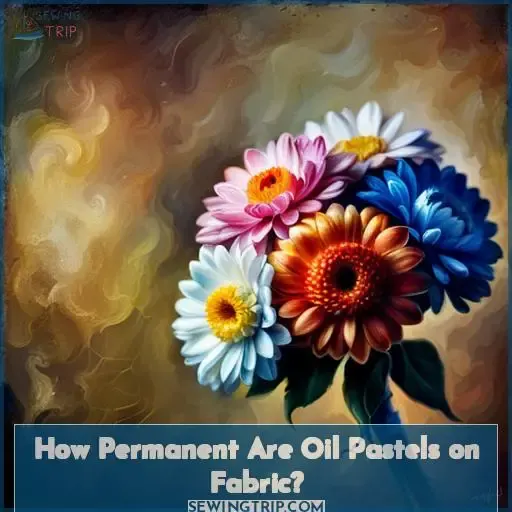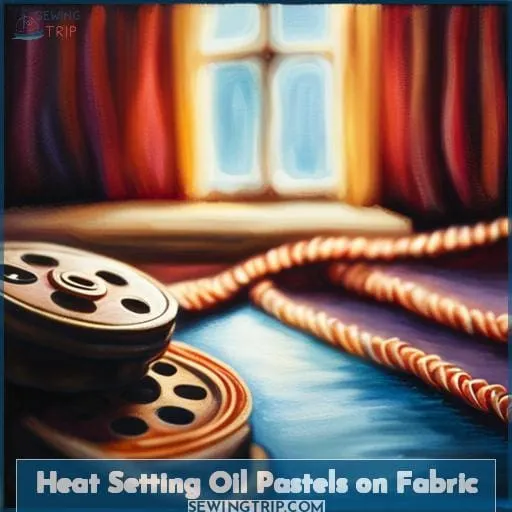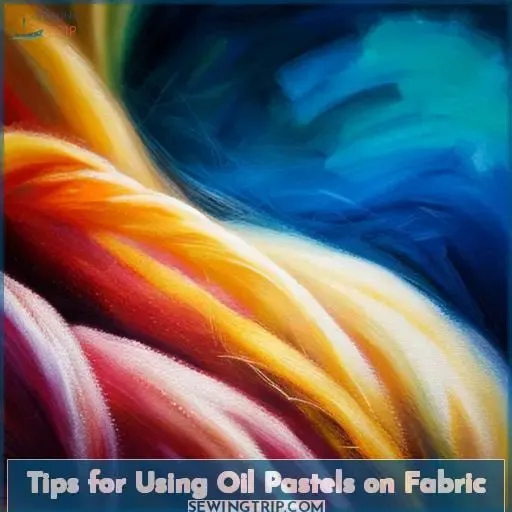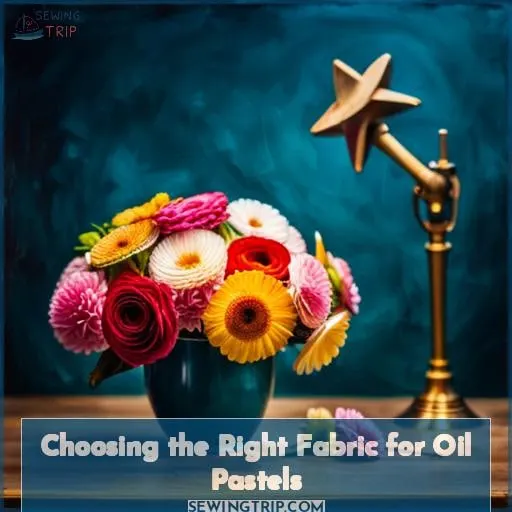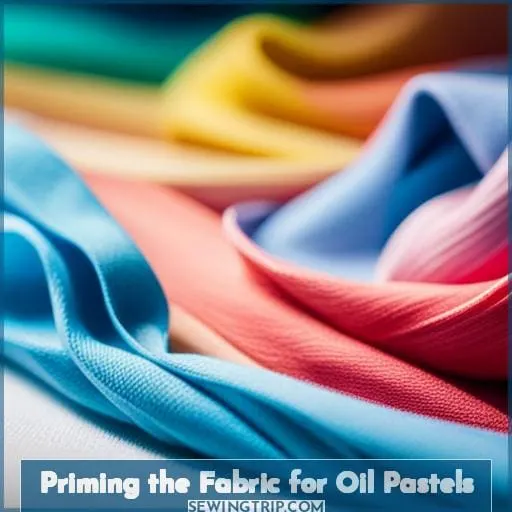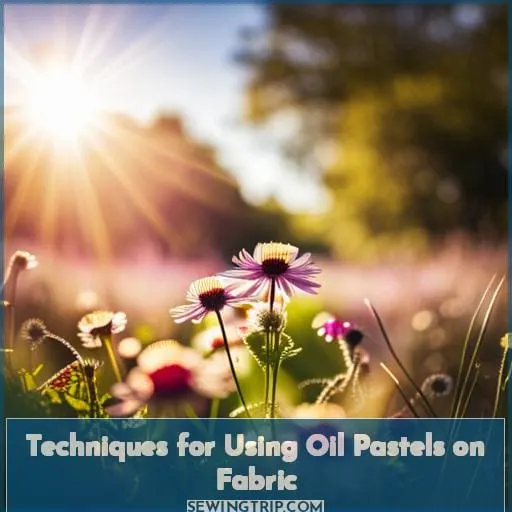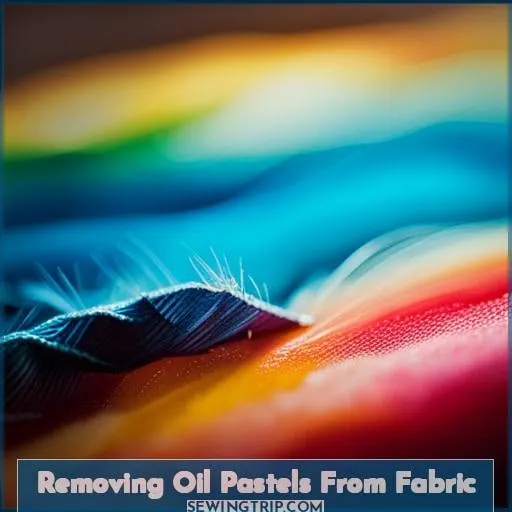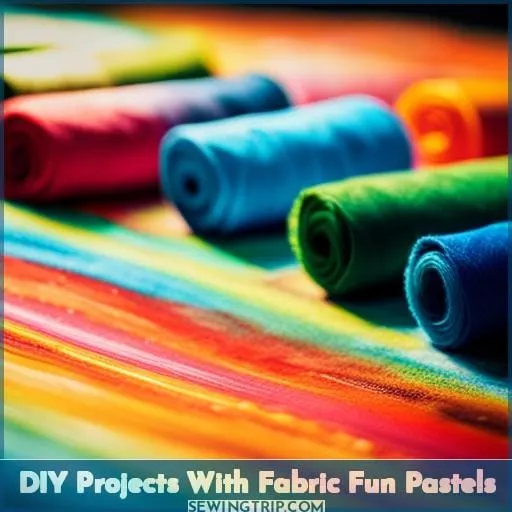This site is supported by our readers. We may earn a commission, at no cost to you, if you purchase through links.
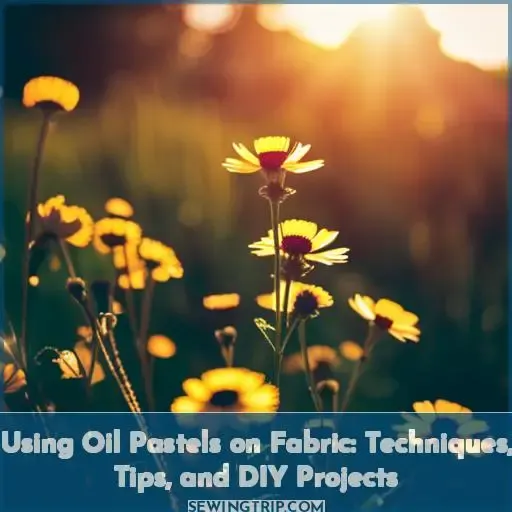 As you look for new ways to express your creativity, have you ever considered using oil pastels on fabric? Not only can they add dimension and contrast, but when used correctly it is possible to produce beautiful works of art.
As you look for new ways to express your creativity, have you ever considered using oil pastels on fabric? Not only can they add dimension and contrast, but when used correctly it is possible to produce beautiful works of art.
In this article we’ll explore how permanent oil pastels are on fabrics, tips for successful application as well as DIY projects that allow you make the most out of this unique material.
So why not give it a try today and see what exciting designs come from combining oil pastel with fabric? The permanency, versatility and bold colors of oil pastels lend themselves well to fabric art. With some preparation and technique, you can create stunning accent pieces and accessories.
Experiment with blending, layers and improvisational drawing to make one-of-a-kind wearable art.
Table Of Contents
- Key Takeaways
- What Are Oil Pastels?
- Can Oil Pastels Be Used on Fabric?
- How Permanent Are Oil Pastels on Fabric?
- Heat Setting Oil Pastels on Fabric
- Tips for Using Oil Pastels on Fabric
- Choosing the Right Fabric for Oil Pastels
- Priming the Fabric for Oil Pastels
- Techniques for Using Oil Pastels on Fabric
- Removing Oil Pastels From Fabric
- DIY Projects With Fabric Fun Pastels
- Conclusion
Key Takeaways
- Oil pastels can be used on fabric to create unique designs.
- Choosing the right fabric and preparing it properly is crucial for good results.
- Heat setting with an iron or using alternative methods is essential to set the design.
- Blending, layering, and scratching techniques can be utilized with oil pastels on fabric.
What Are Oil Pastels?
You’ve got these colorful sticks of pigmented wax that feel like crayons but can blend like paints when drawing right on fabric. Play with blending techniques to mix those vibrant oil pastel hues directly on your textile canvas.
Prep the fabric first for maximum pop of color and oil pastel effects. A thin coat of gesso, matte, or clear acrylic medium allows the pigment to grab and spread smoothly across the fibers.
Protect your wearable art by gently pressing a sheet of wax paper over the design before ironing a hot press cloth on the lowest setting. The heat will set the pastels for crisp lines, solid coverage, and washable results.
Experiment with mark-making tools beyond your fingers – blunt ends and soft bristles give you more control over texture.
Let your inner fashion designer run free with this simple technique to make custom wardrobe pieces and home decor in your own bold aesthetic.
Can Oil Pastels Be Used on Fabric?
While you could mark up fabric with those creamy wax crayons, unfinished results melt away under pressure. Seize the day! Your wardrobe becomes a blank canvas with oil pastels unlocking a wearable art revolution.
Though this medium tempts with rich pigments, not every textile readily receives their embrace. Natural fibers thirst for these luscious oils. Yet man-made materials may repel, failing to fully absorb the colors.
Still, with thoughtful fabric selection, oil pastels help you capture the possibilities dancing through your creative spirit. Experiment! Explore blending, layering, even negative space to channel aesthetic visions into tangible form.
Yes, finished artworks require protection from friction and washing. However, a fixative spray or acrylic topcoat preserves your designs.
Why wait? Grab oil pastels, your favorite garment, iron-on adhesive – fuse fine art with fashion on fabric today.
How Permanent Are Oil Pastels on Fabric?
Without sealing, your art may fade. Oil pastels can create beautiful designs on fabric, but the results aren’t always permanent.
- Choose the right fabric. Lightweight cottons work best as oil pastels adhere to their smooth, tight weave.
- Heat set the design. After the oil pastels thoroughly dry, use an iron on the highest cotton setting to heat seal the waxy pigments into the fabric.
- Seal with an acrylic topcoat. Paint a thin coat of acrylic over the entire design. This creates a barrier to protect the oil pastels from handling, washing, and wear.
With some planning, you can achieve lasting oil pastel art on fabric. Consider the fiber content, give ample drying time, and protect with a topcoat. With a bit of effort, your beautiful blends and vibrant colors can remain on fabric for years to come.
Heat Setting Oil Pastels on Fabric
Have you heat set the oil pastels on your fabric yet? I know you’re eager to make that design permanent, but heat setting oil pastels requires careful thought.
Choosing compatible fabrics like cottons and linens works best, while stretchy synthetics may distort.
Layer a protective barrier like wax paper over the design before ironing. Use a medium dry iron setting and avoid direct steam. Gently iron over the barrier for 30-60 seconds, checking underneath to gauge the heat set.
Repeat if smudging remains. Let it fully cool before removing the protective sheet.
You’ll know it worked if the oil pastels feel dry and don’t smear. With care, this gentle ironing technique secures those vibrant oil pastels to unleash your fabric’s potential.
Celebrate your mastery of this nuanced mixed media technique by creating a custom art quilt or statement apparel piece.
Tips for Using Oil Pastels on Fabric
- Opt for light-colored, tightly woven cottons or linens. Stay away from silks prone to stains.
- Prime fabric first with gesso or acrylic paints. This prevents dye bleeding and smudging.
- Start light, adding darker accents. Avoid areas with frequent abrasion. Focus on flat shapes.
- Heat set pastels between parchment paper. Use a warm iron on medium for 1-2 minutes.
Don’t let any missteps discourage you. Removing oil pastels requires gentle scraping, rubbing alcohol, or ice cubes. With practice, your fabric transforms into a canvas for artistic applications. Let your inner passion shine through.
Choosing the Right Fabric for Oil Pastels
Handmade patterns and embellishments with oil pastels bring a unique style to textiles and apparel. When choosing fabric for oil pastel art, consider using light colors that don’t show smudges easily; prime the surface so the pastels adhere properly; and note that heat setting doesn’t work as well due to the medium’s waxiness.
The light colors help hide smudges that can occur when working with oil pastels. Priming the fabric first allows the pastels to stick to the surface better. Heat setting is not as effective because oil pastels contain wax, which resists heat.
Best fabrics for oil pastels
You’ll find silk takes oil pastels smoothly since its tight weave prevents bleeding. Cotton canvas is ideal for layering and blending oil pastels. The texture grabs the pastels beautifully. For bold, vivid colors, try a linen or cotton blend. The rougher surface reveals the oil pastels’ thick strokes.
Avoid slippery polyesters that resist pigment. Embrace fabrics with some grip that interact with oil pastels for artistic possibilities.
| Fabric Type | Benefits for Oil Pastels |
|---|---|
| Silk | Smooth surface, prevents bleeding |
| Cotton Canvas | Textured, allows blending and layering |
| Linen/Cotton Blend | Rough surface reveals bold strokes |
Priming fabric for oil pastels
Before daring those oil pastels on fabric, prime it first for the best results:
- Mix white paint with water for a basic primer.
- Use soft acrylic paint for vivid, blended colors.
- Try fabric medium to prevent bleeding and improve adhesion.
With proper preparation, your fabric canvas will enable those rich oil pastels to shine, blend, and inspire creativity.
Challenges of heat setting
Utilizing a heat gun to set oil pastels on fabric is a tricky endeavor that risks damaging the material or distorting the artwork. Focus on low synthetic fabrics, like polyester or acrylic. Avoid natural fibers that are prone to scorching, such as cotton and linen.
First, test on small swatches. Keep the heat gun moving to prevent concentrated heat buildup. Have a spray bottle of water handy to cool hot spots immediately. For best results, limit heat setting to small accents or outlines rather than large blocks of color.
Consider alternatives, like priming with acrylics, or simply framing the fabric instead of repeated washing.
Priming the Fabric for Oil Pastels
Embrace the chance to prep your fabric before applying oil pastels. Opting to prime your fabric first lets you apply the oil pastels more smoothly and vibrantly. Remember oil pastels contain oil that may not fully dry or permanently bond with fabric.
Priming creates a protective barrier layer on the fabric’s surface. Consider acrylic paints or fabric mediums as affordable priming options. They dry clear and add a layer between the fabric and oil pastels. For kids’ art projects, fun fabrics like muslin or canvas also respond well to priming.
Prep your fabric first and discover oil pastels’ creative potential on fabric. With a primed surface, experience the vibrant colors and textured effects possible. Let go of doubts, prime with purpose and enjoy the process. Your primed fabric awaits oil pastels coming to life in a dance.
Techniques for Using Oil Pastels on Fabric
You’ll boost depth and shading by layering the oil pastels on your scarf. For example, start with lighter colors and pressure, then intensify the hues and force for dramatic highlights.
- Begin with large color blocks and blending, then refine details.
- Use a light touch initially, then bear down for saturated colors.
- Scratch into layers with the edge of a pastel for unique textures.
- Dust away excess pastel between layers with a dry brush.
Oil pastels open up a world of artistic possibilities on fabric. Experiment with blending, textures, and combinations until your scarf reflects your vision. The ironing process transforms the pastels into a washable medium, so don’t hold back in crafting your masterpiece.
Removing Oil Pastels From Fabric
Don’t fret over smudged oil pastels staining your treasured fabric, for gentle scraping or rubbing alcohol lifts those blemishes.
Using a plastic scraper, gently lift oil pastel residue from fabric with small, circular motions. For deeper stains, dip a cotton swab in rubbing alcohol and dab onto the stain, working from the outside in.
Finally, place an ice cube on any remaining stain and let the cold temperature harden the pastel for easier removal.
With a little patience and the right techniques, you can restore your fabric to its original beauty. Try these solutions first before attempting harsher chemicals that may damage the fabric. And remember – oil pastels, while fun for fabric art, run the risk of permanent stains.
So keep a favorite keepsake quilt free of embellishment or test an inconspicuous area first.
| Method | Tools Needed | Tips |
|---|---|---|
| Scraping | Plastic scraper, toothbrush | Use gentle, circular motions |
| Rubbing Alcohol | Cotton swabs, rubbing alcohol | Dab from outside in |
| Ice Cube | Ice cube, paper towel | Let cold harden pastel residue |
DIY Projects With Fabric Fun Pastels
Hug your creativity close as you fashion fun fabric designs with Fabric Fun pastels and simple techniques. Draw or trace your design onto paper, place the paper on your fabric, then iron to transfer the pastel artwork.
Like magic, the pastels release from the paper and adhere permanently to the fabric. Simply iron over the design after 24 hours to seal and set the color. This easy process opens up endless wearable creations – bold patterned shirts, artistic scarves, and personalized DIY gifts.
A few ideas to stir your imagination:
- Decorate a heart motif on a sweater for your Valentine.
- Add a burst of geometric shapes to a silk scarf.
- Print your child’s handprint on a baby blanket.
Let your inner artist play and make your mark on the world through fabric. Discover the liberating possibilities of effortless art with Fabric Fun pastels.
Conclusion
Using oil pastels on fabric is an exciting way to create unique designs! With a bit of preparation and the right tools, you can achieve stunning results. It’s important to remember that oil pastels aren’t fully permanent on fabric, and that heat setting is tricky.
Choose the right fabric and prime it before using oil pastels, and don’t forget to cover your design with acrylic paint for extra protection. With the right techniques, like blending and layering, you’ll create beautiful pieces.
If you’re looking for a fun and easy project, check out the DIY projects with Fabric Fun pastels.

